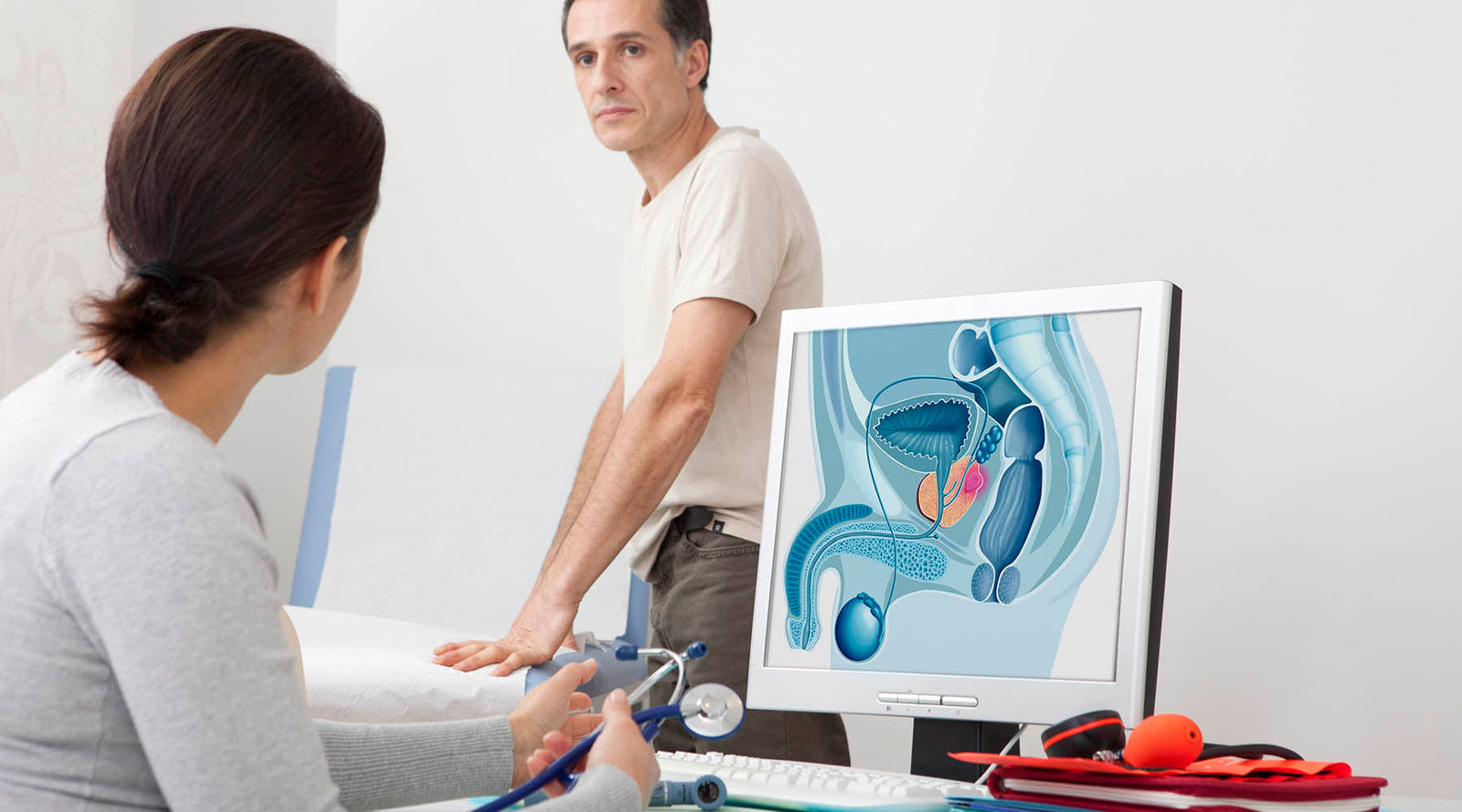How It Works Mobile
Health Benefits Mobile

How to Best Prepare For And Recover From Prostate Cancer Surgery
How to Best Prepare For And Recover From Prostate Cancer Surgery
5 min read
5 min read
Prostate cancer surgery can impact sexual function, bladder control, and overall well-being, but the proper preparation and recovery plan can make a big difference. Here’s how to optimize your health before and after surgery for the best possible outcome.

Science-based guidance to improve your sexual health & performance.
By The Private Gym Team
Having your prostate removed is an effective means of curing prostate cancer. Unfortunately, because of the prostate’s “precarious” location - at the crossroads of the urinary and genital tracts, connected to the bladder on one end, the urethra on the other, touching upon the rectum, and nestled behind the pubic bone in a well-protected nook of the body - its removal has the potential for causing unwanted and undesirable side effects. By strengthening the all-important pelvic floor muscles prior to and after surgery, patients can reduce the negative effects of the surgery with respect to urinary control and sexual function.
SIDE EFFECTS OF PROSTATE CANCER SURGERY
Trauma to nerves, blood vessels, and muscular tissue during surgery can compromise sexual function and urinary control. A small percentage of men experience significant urinary incontinence, whereas many men experience mild leakage. Many men note a decline in their ability to obtain and maintain an erection after the surgery. Additional sexual-related side effects that may occur include urinary leakage with foreplay and arousal; ejaculation of urine at the time of sexual climax; less intense orgasms and possibly pain with climax; a change in penile size with a decrease in length, and girth; and possibly a penile deformity.
THE IMPORTANCE OF STRENGTHENING THE PELVIC FLOOR MUSCLES
Numerous studies have shown the benefits of pelvic floor muscle training after prostate surgery in terms of hastening the recovery of urinary control and significantly improving the severity of the incontinence. Studies have also demonstrated the beneficial impact of such training on the recovery of erectile function with respect to the duration and severity of the erectile dysfunction. Because of the potential urinary and sexual side effects of radical prostatectomy, it is a prudent strategy to commit to a program of Kegel pelvic floor exercises both before and after the prostate surgery. It makes sense to become proficient in these exercises proactively - before the trauma of surgery - so you go into the operation armed with precise knowledge and awareness of the pelvic floor muscles as well as with their strength, power and endurance optimized.
THE PRINCIPLES OF ARNOLD KEGEL
A quality pelvic floor muscle training program must be well-designed and adhere to the 4 principles promoted by Arnold Kegel, the namesake of pelvic floor muscle training:
- Muscle education
- Biofeedback
- Progressive intensity
- Resistance
1. Muscle education is an understanding of your pelvic floor muscle anatomy and function. Most men are clueless as to where their pelvic floor muscles are, what they do, how to exercise them, and what benefits they confer. In fact, many men don’t even know that they have pelvic floor muscles! Muscle education gives you the wherewithal to develop muscle memory—the development of the nerve pathway from your brain to your pelvic floor muscles.
2. Feedback is a means of confirming that you are exercising the proper muscles.
3. Progressive intensity. Over the course of time, you gradually increase reps (number of repetitions), intensity of contraction and duration of contraction. Progression is the key to increasing your pelvic floor muscle strength and endurance. Additionally, it allows you to measure and monitor you progress and witness your increased capabilities over time.
4. Resistance adds a dimension that further challenges the growth of your pelvic floor muscles. Working your pelvic muscles against resistance rapidly escalates their strength and endurance, since muscle growth occurs in direct proportion to the demands and resistances placed upon them, a basic principle of muscle physiology. It is similar to the difference between doing arm curls without weights versus with weights.
HOW TO STRENGTHEN THE PELVIC FLOOR MUSCLES D.I.Y.
One possibility is a D.I.Y. (Do It Yourself) program, but the problem lies in sticking with it and seeing it through in order to reap meaningful results. D.I.Y. Kegels lack the foundational background and the means of isolating and exercising the pelvic floor muscles in a progressively more challenging fashion. It is like handing someone a set of weights and expecting them to engage in a program without the essential knowledge and principles of anatomy and function, specific exercise routine and supervision to go along with the equipment, dooming them to most certain failure.
PHYSICAL THERAPY
Pelvic floor physical therapy is the other extreme from D.I.Y. This involves using the services of a physical therapist who specializes in the pelvic floor. I liken the pelvic floor physiotherapist to a “personal trainer” for the pelvic floor muscles. Pelvic floor physiotherapists have the training, tools and wherewithal to educate and instruct those in need. The downside is that physical therapy usually has to be done onsite at a physical therapy center and is both time-consuming and expensive with variable insurance coverage, depending on the carrier.
THE PRIVATE GYM PELVIC FLOOR MUSCLE TRAINING PROGRAM
This program gives one the advantages and benefits of pelvic floor physical therapy training, but in a D.I.Y. environment. In many ways, it is like the highly successful P90X® home training program, which I am a big fan of. The Private Gym is the go-to means of gaining pelvic floor muscle proficiency for men who are scheduled for prostate cancer surgery and wish to train in a comfortable home environment with minimal expense. It is a comprehensive, interactive, easy-to-use, medically sanctioned and FDA registered follow-along exercise program that builds upon the foundational work of Dr. Kegel.
The Basic Training program strengthens the pelvic floor muscles with a series of progressive “Kegel” exercises, while the Complete Training program provides maximum opportunity for gains via resistance equipment. It is recommended that the Complete Training program be used in preparation for prostate surgery because of the importance of using resistance to maximize the strength of the pelvic floor muscles. The Basic Training program can be started once sufficiently healed from surgery, with gradual progression to Complete Training at the appropriate time.
A clinical trial of the Private Gym program showed dramatic increases in the magnitude of pelvic floor muscle contractions, vastly exceeding measurements in the control group. The study demonstrated better quality erections, orgasms, ejaculatory control and sexual pleasure with a striking improvement in sexual confidence in virtually all participants. The study not only revealed improved erectile function in men with mild ED, but it also showed enhanced erections and ejaculation in men without ED, with the resistance program expediting the results beyond the capacity of the non-resistance program.
For more details about the results of the clinical trial please visit: http://www.privategym.com/how-it-works/clinical-trial-results/
BOTTOM LINE: "FAILURE TO PREPARE IS PREPARING TO FAIL."
Before embarking on prostate surgery, make every effort to get in the best general physical shape as well as achieve the best pelvic fitness possible. Yet another reason to exercise, eat properly, and maintain a healthy lifestyle are the advantages that accrue when you get ill and need surgery. A prepared pelvic floor does wonders in helping to recover erections and urinary control.
ABOUT THE AUTHOR
Andrew Siegel, M.D., Urologist, Co-founder of The Private Gym, and author of the highly acclaimed book, Male Pelvic Fitness, Optimizing Your Sexual and Urinary Health.
The Private Gym Program is the first FDA-registered pelvic muscle training system for men. In a four-month clinical trial, 75% of men improved erectile rigidity and 90% reported great improvement in their sexual self-confidence. Learn more about how you can strengthen and maintain these critical muscles at www.privategym.com.
RELATED ARTICLES

How to Keep Your Prostate Happy and Healthy
8 min read

How To Get Ready for Prostate Surgery
4 min read
Recent Articles
- 12 Types of Female Orgasms: How to Help Her Experience Each One
- Why I Recommend You Get a Tantric Couch
- The Downsides of Penis Enlargement Surgery: Risks and Alternatives
- Bathmate vs. Air Pumps
- Bathmate Results: Penis Pump Before & After
- Side Effects of Catuaba
- Health Benefits of Catuaba
- 12 Essential Tips for a Healthy Penis
- Can Quadriplegic Men Have Sex?
- Sexual Function for Men After Spinal Cord Injury































